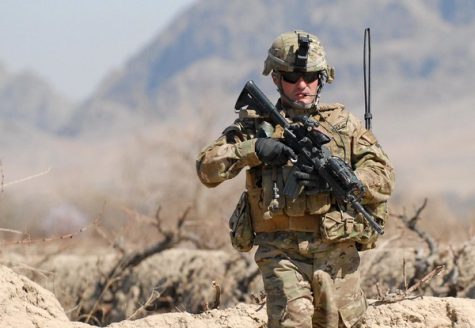A deeper look into Afghanistan’s ongoing conflict
U.S. military personnel had been stationed in Afghanistan for 20 years, but America’s history with the country goes back to almost 70 years ago.
August 30, 2021, marks the end of the “forever” war in Afghanistan. After nearly 20 years of conflict, the U.S. finally pulled all military personnel out of the country. But to really understand this conflict, we have to go back almost 70 years ago.
Russia and the U.S. both fought to influence Afghanistan through infrastructure investments and military intervention from the 1950s-1970s (the midst of the Cold War). In 1978, the head of Afghanistan, Daoud Khan, was overthrown and a Marxist group took over. America slowly started funneling money towards the Afghan Mujahideen (four different types of resistance groups roughly aligned against the Soviets). This funding was done through Pakistan’s intelligence services (ISI), which was then given to the more organized pockets of the resistance group. In turn, the more organized factions of Mujahideen were the more reactionary elements of the group.
The U.S. then pressured Egypt into releasing a group of Islamists who were in jail, one of which was Ayman al-Zawahiri, who ended up becoming al-Qaeda’s second in command. America also started to bring in people from Egypt’s Muslim Brotherhood, who were from Yemen and Saudi Arabia. These people would go on to form al-Qaeda years later.
In 1989, America and Russia pulled out of Afghanistan, plunging the country into a civil war that gave birth to the Taliban and al-Qaeda. Both groups had American guns and training due to the previous U.S. funding.
By the 1990s, the Taliban had exerted its authority over most of Afghanistan. Al-Qaeda bombed the World Trade Center in 1993. The group also took credit for attacks on U.S. embassies in Tanzania and Kenya in 1998, and for the suicide bombings against the U.S.S. Cole in Yemen in 2000. Fatefully in 2001, they hijacked and crashed two commercial airplanes into both World Trade Center towers, as well as one plane into the Pentagon. Since the Taliban provided protection to Osama Bin-Laden, the leader of al-Qaeda, America focused on Afghanistan when they started their ‘war on terror’ after 9/11. They began with a bombing campaign since the Taliban had no air force. As you can imagine, the Taliban collapsed fairly quickly, with no air force to defend themselves from the bombings.

They offered to give up Bin-Laden, but to a third party and for a trial to be held for Bin-Laden. The Bush Administration didn’t accept this offer, and a formal invasion was undertaken. The Taliban completely vanished after this invasion and hid away in Pakistan’s mountain ranges.
Once Bin-Laden was killed in 2011, there was an uncertainty of why the U.S. chooses to continue it’s occupancy. The first mission (killing Bin-Laden and seeking revenge) was carried out, so why were we still there? Well, America decided that they needed to help build Afghanistan’s government back up. The main reasons that the Bush Administration decided to stay was so they could create a pro-American government, gain a foothold in the country, and then be able to extend American military bases.
The U.S. flooded Afghanistan with money, which ended up in the hands of military contractors and advisors, who became pretty well off due to the U.S’s investments. This left a huge economic gap between the people of Afghanistan and the people receiving America’s money. Jobs were incredibly hard to come by. The rural parts of Afghanistan mainly remained neglected, and a few skyscrapers were developed in Kabul.
While the U.S. did some good things for the economy in Afghanistan, they also continued the war. Bombing campaigns were still in progress, and so were droning campaigns. It was a complicated feeling for the citizens of Afghanistan, this country that was creating new opportunities and jobs was also the ones driving tanks down the street.
Finally, we come to August of 2021, when President Joe Biden ordered that all military troops and personnel were to be pulled out of Afghanistan. The withdrawal of troops was impending though, with the previous president, Donald Trump, starting to lessen the amount of troops stationed there during his term. Biden’s move was controversial, with people claiming that we abandoned the Afghanistan citizens, especially the ones that aided America during this war. There has also been fear that Afghanistan will collapse into another civil war within the next few years, what will America do then? There is a nationwide and maybe even worldwide acceptance and celebration of this withdrawal, but this withdrawal also raises many major questions that only time can answer.
Your donation will support the student journalists of West High School. Your contribution will allow us to purchase Scholarship Yearbooks, newsroom equipment and cover our annual website hosting costs.

(she/her) Laney Prelle is a senior at West High and this is her fourth year on staff. She is the online profiles editor and her hobbies outside of writing...

(she/her) She is a senior this year, and she is also the Co-Managing Editor and Podcast Editor for web this year. In her free time, you can find her at...


